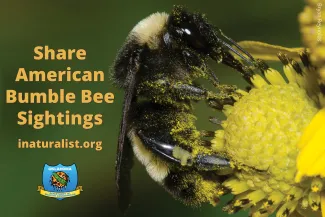Backyard gardens and flowerbeds are buzzing with bees this spring and the Oklahoma Department of Wildlife Conservation is asking Oklahomans to share sightings of a specific bee, the American bumble bee, on iNaturalist. The free online crowdsourcing platform allows nature enthusiasts to connect with biologists as well as a larger community of naturalists.

“Sharing a photo along with the date and location of your sighting helps us better understand the status of this important pollinator,” said Matt Fullerton, Wildlife Department biologist. “And iNaturalist makes it really easy to add photos and observation details on their website and app (available for Apple and Android devices) – it takes only a few clicks to add an observation from your phone.”
American bumble bees play an important role in nature as part of the pollinator community. These bees, along with other native pollinators, help pollinate many plants, which in turn ensure important food sources used by many other wildlife species are available the next year. Queen American bumble bees emerge from their hibernation burrows in early to mid spring and begin creating an underground colony of worker bees. New queens and male bees are produced in autumn, and all but mated queens die before winter.
“Bumble bees are pretty familiar insects for most Oklahomans – we have at least 10 species in our state and they’re all generally large bees with a black and yellow body, and hairy abdomens,” Fullerton said. “But what makes American bumble bees identifiable is the pattern of the black and yellow bands.”
American bumble bees have three black and two yellow bands. The first yellow band is just behind the eyes on the thorax or body of the bee, with the second band located in the middle of the abdomen. Because identification hinges on this pattern, photos should be included with sighting information. Photos are most beneficial when they show the entire back of an individual bee.
“iNaturalist has several built-in features to help with identification. When you upload an observation and photo by phone, it automatically generates suggestions based on visually similar species or species that have been reported in the area. Fellow iNaturalists can also view your observations and suggest identifications,” Fullerton said. “So if you’re unsure the bee you saw was an American bumble bee, you can simply record it as a ‘bumble bee’ and lean on the iNaturalist community to help narrow the identification."